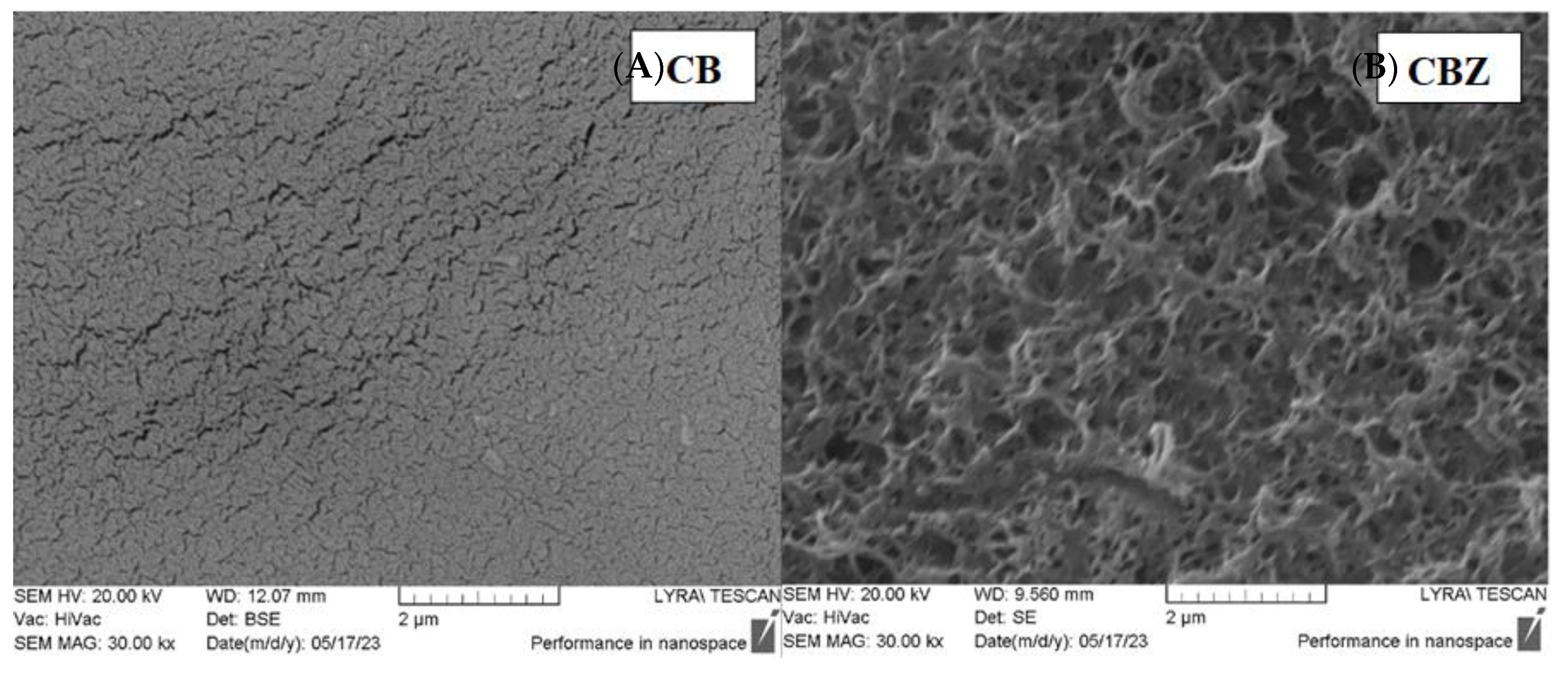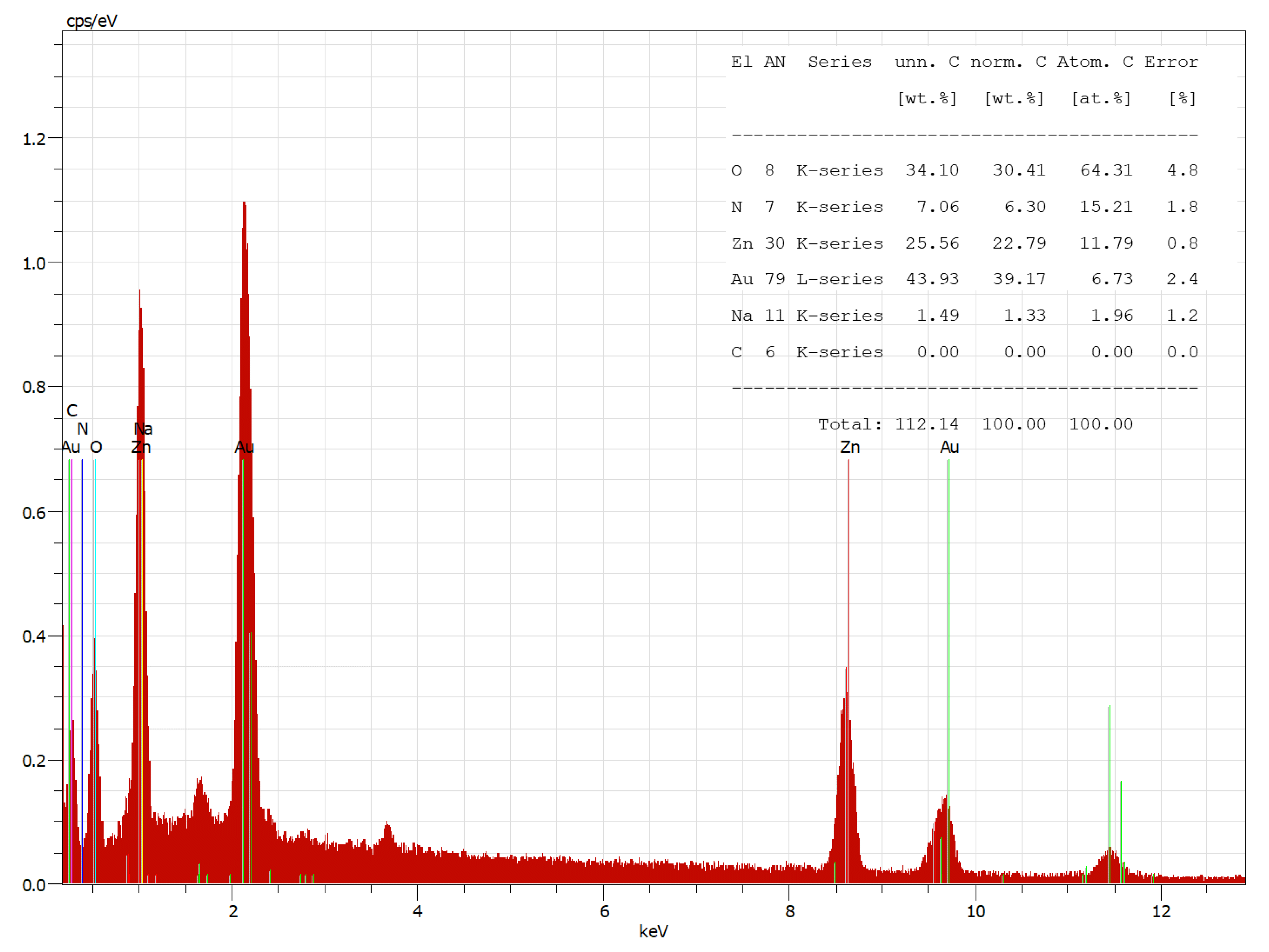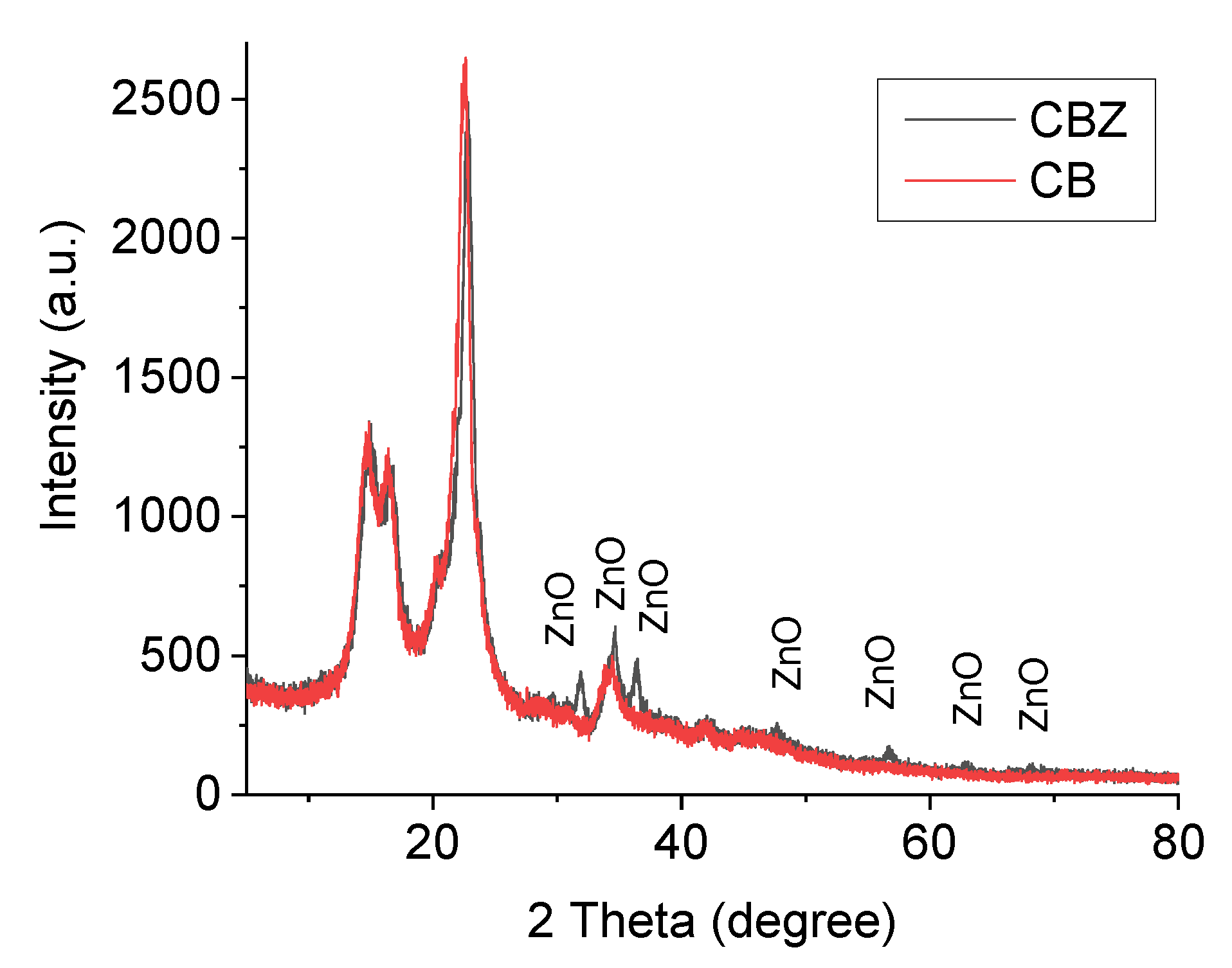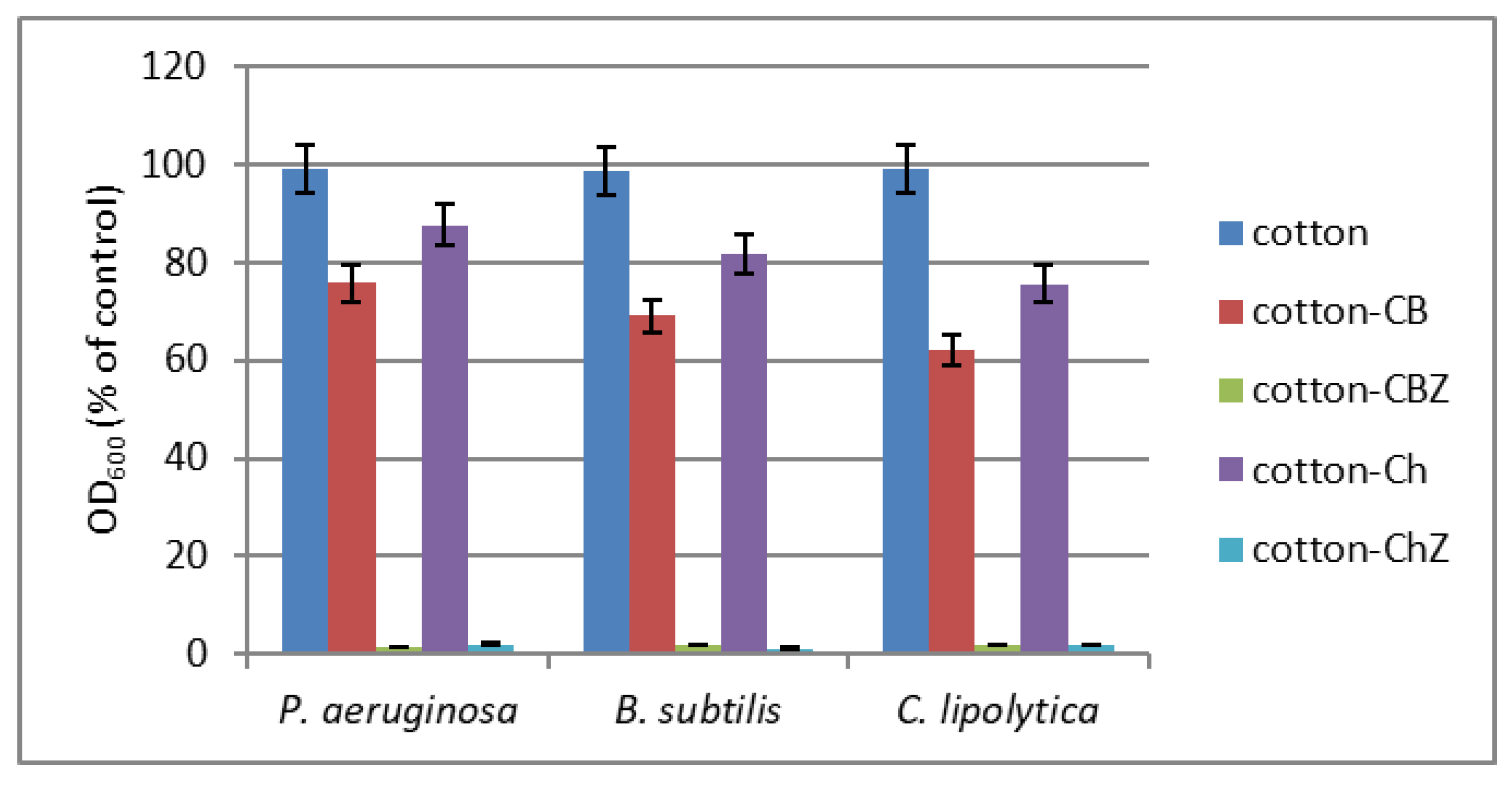Antimicrobial Properties of Chitosan-Modified Cotton Fabric Treated with Aldehydes and Zinc Oxide Particles
Abstract
:1. Introduction
2. Materials and Methods
2.1. Materials
2.2. Preparation of Composite Materials
2.2.1. Preparation of the Solution for Fabric Treatment
- The chitosan (2.7% w/v) was dissolved in water under stirring, with the gradual addition of glacial acetic acid (1% v/v) to obtain a clear viscous solution.
- The chitosan (2.7% w/v) and Zn(NO3)2 × 6H2O (2.7% w/v) were dissolved in water with the gradual addition of glacial acetic acid (1% v/v) to obtain a clear viscous solution.
- A solution of benzaldehyde in ethanol at a concentration of 90μL/mL was prepared.
- Solution (3) was added to solution (1) at 60 °C, and stirring continued for 2 h.
- Solution (3) was added to solution (2) at 60 °C, and stirring continued for 2 h.
2.2.2. Cotton Fabric Treatment
- 6.
- Sample CB
- 7.
- Sample CBZ
2.3. Characterization
2.4. Antimicrobial Assay
2.4.1. Antibacterial and Antifungal Assay
2.4.2. Virucidal Assay
3. Results and Discussion
3.1. FTIR Characterization of the Composite Materials
3.2. Thermogravimetric Analysis of the Cotton Fabric and the CB and CBZ Composite Materials
3.3. Morphological Properties of the Composites
3.3.1. Optical Microscope Observation
3.3.2. SEM Analysis
3.3.3. Contact Angle Measurement
3.3.4. X-ray Diffraction (XRD)
3.4. Antimicrobial Activity
3.4.1. Antibacterial and Antifungal Activity
3.4.2. Virucidal Activity
4. Conclusions
Author Contributions
Funding
Institutional Review Board Statement
Informed Consent Statement
Data Availability Statement
Conflicts of Interest
References
- Panthee, B.; Gyawali, S.; Panthee, P.; Techato, K. Environmental and Human Microbiome for Health. Life 2022, 12, 456. [Google Scholar] [CrossRef]
- Gao, Y.; Cranston, R. Recent Advances in Antimicrobial Treatments of Textiles. Text. Res. J. 2008, 78, 60–72. [Google Scholar] [CrossRef]
- Gulati, R.; Sharma, S.; Sharma, R.K. Antimicrobial textile: Recent developments and functional perspective. Polym. Bull. 2021, 79, 5747–5771. [Google Scholar] [CrossRef] [PubMed]
- Brooks, B.D.; Brooks, A.E. Therapeutic strategies to combat antibiotic resistance. Adv. Drug Deliv. Rev. 2014, 78, 14–27. [Google Scholar] [CrossRef]
- Morais, D.S.; Guedes, R.M.; Lopes, M.A. Antimicrobial Approaches for Textiles: From Research to Market. Materials 2016, 9, 498. [Google Scholar] [CrossRef] [Green Version]
- Pham, T.T.P.; Oliver, S.; Wong, E.H.H.; Boyer, C. Effect of hydrophilic groups on the bioactivity of antimicrobial polymers. Polym. Chem. 2021, 12, 5689–5703. [Google Scholar] [CrossRef]
- Pham, P.; Oliver, S.; Boyer, C. Design of Antimicrobial Polymers. Macromol. Chem. Phys. 2023, 224, 202200226. [Google Scholar] [CrossRef]
- Chindera, K.; Mahato, M.; Sharma, A.K.; Horsley, H.; Kloc-Muniak, K.; Kamaruzzaman, N.F.; Kumar, S.; McFarlane, A.; Stach, J.; Bentin, T.; et al. The antimicrobial polymer PHMB enters cells and selectively condenses bacterial chromosomes. Sci. Rep. 2016, 6, 23121. [Google Scholar] [CrossRef] [PubMed] [Green Version]
- Staneva, D.; Grabchev, I. Modification of textile with stimuli responsive polymers. In Encyclopedia of Polymer Applications; Mishra, M., Ed.; Taylor & Francis: London, UK, 2018. [Google Scholar]
- Mahanta, U.; Khandelwal, M.; Deshpande, A.S. Antimicrobial surfaces: A review of synthetic approaches, applicability and outlook. J. Mater. Sci. 2021, 56, 17915–17941. [Google Scholar] [CrossRef]
- Mocanu, G.; Nichifor, M.; Mihai, D.; Oproiu, L. Bioactive cotton fabrics containing chitosan and biologically active substances extracted from plants. Mater. Sci. Eng. C 2012, 33, 72–77. [Google Scholar] [CrossRef]
- Jain, A.; Duvvuri, L.S.; Farah, S.; Beyth, N.; Domb, A.J.; Khan, W. Antimicrobial Polymers. Adv. Healthc. Mater. 2014, 3, 1969–1985. [Google Scholar] [CrossRef] [PubMed]
- Xing, Y.; Xu, Q.; Li, X.; Chen, C.; Ma, L.; Li, S.; Che, Z.; Lin, H. Chitosan-Based Coating with Antimicrobial Agents: Preparation, Property, Mechanism, and Application Effectiveness on Fruits and Vegetables. Int. J. Polym. Sci. 2016, 2016, 1–24. [Google Scholar] [CrossRef] [Green Version]
- Takeshita, S.; Konishi, A.; Takebayashi, Y.; Yoda, S.; Otake, K. Aldehyde Approach to Hydrophobic Modification of Chitosan Aerogels. Biomacromolecules 2017, 18, 2172–2178. [Google Scholar] [CrossRef] [PubMed]
- Lim, S.-H.; Hudson, S.M. Application of a fiber-reactive chitosan derivative to cotton fabric as an antimicrobial textile finish. Carbohydr. Polym. 2004, 56, 227–234. [Google Scholar] [CrossRef]
- Gupta, K.; Jabrail, F.H. Glutaraldehyde cross-linked chitosan microspheres for controlled release of centchroman. Carbohydr. Res. 2007, 342, 2244–2252. [Google Scholar] [CrossRef]
- Toteva, V.; Staneva, D.; Grabchev, I. Pollutants Sorbent Made of Cotton Fabric Modified with Chitosan-Glutaraldehyde and Zinc Oxide Particles. Materials 2021, 14, 3242. [Google Scholar] [CrossRef]
- Abbasipour, M.; Mirjalili, M.; Khajavi, R.; Majidi, M.M. Coated Cotton Gauze with Ag/ZnO/chitosan Nanocomposite as a Modern Wound Dressing. J. Eng. Fibers Fabr. 2014, 9, 124–130. [Google Scholar] [CrossRef]
- Alharbi, R.A.; Alminderej, F.M.; Al-Harby, N.F.; Elmehbad, N.Y.; Mohamed, N.A. Design, Synthesis, and Characterization of Novel Bis-Uracil Chitosan Hydrogels Modified with Zinc Oxide Nanoparticles for Boosting Their Antimicrobial Activity. Polymers 2023, 15, 980. [Google Scholar] [CrossRef]
- Noman, M.T.; Amor, N.; Petru, M.; Mahmood, A.; Kejzlar, P. Photocatalytic Behaviour of Zinc Oxide Nanostructures on Surface Activation of Polymeric Fibres. Polymers 2021, 13, 1227. [Google Scholar] [CrossRef]
- Mandal, A.K.; Katuwal, S.; Tettey, F.; Gupta, A.; Bhattarai, S.; Jaisi, S.; Bhandari, D.P.; Shah, A.K.; Bhattarai, N.; Parajuli, N. Current Research on Zinc Oxide Nanoparticles: Synthesis, Characterization, and Biomedical Applications. Nanomaterials 2022, 12, 3066. [Google Scholar] [CrossRef]
- Shehabeldine, A.M.; Hashem, A.H.; Wassel, A.R.; Hasanin, M. Antimicrobial and Antiviral Activities of Durable Cotton Fabrics Treated with Nanocomposite Based on Zinc Oxide Nanoparticles, Acyclovir, Nanochitosan, and Clove Oil. Appl. Biochem. Biotechnol. 2022, 194, 783–800. [Google Scholar] [CrossRef] [PubMed]
- Afzal, F.; Ashraf, M.; Manzoor, S.; Aziz, H.; Nosheen, A.; Riaz, S. Development of novel antiviral nanofinishes for bioactive textiles. Polym. Bull. 2022, 80, 8447–8466. [Google Scholar] [CrossRef] [PubMed]
- Jana, B.; Chatterjee, A.; Roy, D.; Ghorai, S.; Pan, D.; Pramanik, S.K.; Chakraborty, N.; Ganguly, J. Chitosan/benzyloxy-benzaldehyde modified ZnO nano template having optimized and distinct antiviral potency to human cytomegalovirus. Carbohydr. Polym. 2022, 278, 118965. [Google Scholar] [CrossRef]
- Wilson, R.H.; Smith, A.C.; Kacuráková, M.; Saunders, P.K.; Wellner, N.; Waldron, K.W. The Mechanical Properties and Molecular Dynamics of Plant Cell Wall Polysaccharides Studied by Fourier-Transform Infrared Spectroscopy. Plant Physiol. 2000, 124, 397–406. [Google Scholar] [CrossRef] [PubMed] [Green Version]
- Hong, T.; Yin, J.-Y.; Nie, S.-P.; Xie, M.-Y. Applications of infrared spectroscopy in polysaccharide structural analysis: Progress, challenge and perspective. Food Chem. X 2021, 12, 100168. [Google Scholar] [CrossRef] [PubMed]
- Balau, L.; Lisa, G.; Popa, M.I.; Tura, V.; Melnig, V. Physico-chemical properties of Chitosan films. Cent. Eur. J. Chem. 2004, 2, 638–647. [Google Scholar] [CrossRef]
- Hassan, M.A.; Omer, A.M.; Abbas, E.; Baset, W.M.A.; Tamer, T.M. Preparation, physicochemical characterization and antimicrobial activities of novel two phenolic chitosan Schiff base derivatives. Sci. Rep. 2018, 8, 11416. [Google Scholar] [CrossRef] [Green Version]
- John, A.; Ko, H.-U.; Kim, D.-G.; Kim, J. Preparation of cellulose-ZnO hybrid films by a wet chemical method and their characterization. Cellulose 2011, 18, 675–680. [Google Scholar] [CrossRef]
- Bohmwald, K.; Espinoza, J.A.; Rey-Jurado, E.; Gómez, R.S.; González, P.A.; Bueno, S.M.; Riedel, C.A.; Kalergis, A.M. Human Respiratory Syncytial Virus: Infection and Pathology. Semin. Respir. Crit. Care Med. 2016, 37, 522–537. [Google Scholar] [CrossRef]
- Monteiro, G.S.; Staggemeier, R.; Klauck, C.R.; Bernardes, A.M.; Rodrigues, M.A.S.; Spilki, F.R. Degradation and inactivation of adenovirus in water by photo-electro-oxidation. Braz. J. Biol. 2015, 75 (Suppl. S2), S37–S42. [Google Scholar] [CrossRef] [Green Version]











| Surface Energy (mN/m) | |||
|---|---|---|---|
| Solutions | σ1 | σd1 | σp1 |
| H2O | 72.8 | 21.8 | 51.0 |
| CH2I2 | 50.8 | 50.8 | 0 |
| Cellulose (cm−1) | Chitosan (cm−1) | Functional Groups |
|---|---|---|
| 1256 | w 1200 | C-O-H |
| 1150 | 1151 | ν (C-O-C), |
| 1125, 1110 | 1110 | ν (CO), ν (CC), ring |
| 1078 | 1080 | ν (CO), ν (CC), ring |
| 1034 | 1035 | C-C-O, C-O-C, ring |
| 895 | 895 | β-glucoside bond |
| Sample | Contact Angle | Free Surface Energy (mN/m) | |||
|---|---|---|---|---|---|
| θH2O [°] | θCH2I2 [°] | σs0 | σds0 | σ ps0 | |
| CB | 77.13 ± 0.91 | 53.30 ± 2.10 | 38.72 | 32.41 | 6.31 |
| CBZ | 101.76 ± 1.14 | 51.45 ± 1.73 | 33.59 | 33.46 | 0.13 |
| Virus | Δlog 30 min | Δlog 60 min | ||
|---|---|---|---|---|
| CB | CBZ | CB | CBZ | |
| HRSV-2 | 0 | 0 | 0.1 | 0.9 |
| HAdV-5 | 0 | 0 | 0.3 | 0.9 |
Disclaimer/Publisher’s Note: The statements, opinions and data contained in all publications are solely those of the individual author(s) and contributor(s) and not of MDPI and/or the editor(s). MDPI and/or the editor(s) disclaim responsibility for any injury to people or property resulting from any ideas, methods, instructions or products referred to in the content. |
© 2023 by the authors. Licensee MDPI, Basel, Switzerland. This article is an open access article distributed under the terms and conditions of the Creative Commons Attribution (CC BY) license (https://creativecommons.org/licenses/by/4.0/).
Share and Cite
Staneva, D.; Atanasova, D.; Angelova, D.; Grozdanov, P.; Nikolova, I.; Grabchev, I. Antimicrobial Properties of Chitosan-Modified Cotton Fabric Treated with Aldehydes and Zinc Oxide Particles. Materials 2023, 16, 5090. https://doi.org/10.3390/ma16145090
Staneva D, Atanasova D, Angelova D, Grozdanov P, Nikolova I, Grabchev I. Antimicrobial Properties of Chitosan-Modified Cotton Fabric Treated with Aldehydes and Zinc Oxide Particles. Materials. 2023; 16(14):5090. https://doi.org/10.3390/ma16145090
Chicago/Turabian StyleStaneva, Desislava, Daniela Atanasova, Daniela Angelova, Petar Grozdanov, Ivanka Nikolova, and Ivo Grabchev. 2023. "Antimicrobial Properties of Chitosan-Modified Cotton Fabric Treated with Aldehydes and Zinc Oxide Particles" Materials 16, no. 14: 5090. https://doi.org/10.3390/ma16145090







